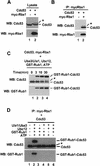The Rbx1 subunit of SCF and VHL E3 ubiquitin ligase activates Rub1 modification of cullins Cdc53 and Cul2
- PMID: 10579999
- PMCID: PMC317157
- DOI: 10.1101/gad.13.22.2928
The Rbx1 subunit of SCF and VHL E3 ubiquitin ligase activates Rub1 modification of cullins Cdc53 and Cul2
Abstract
The RING-H2 finger protein Rbx1 is a subunit of the related SCF (Skp1-Cdc53/Cul1-F-box protein) and von Hippel-Lindau (VHL) tumor suppressor (elongin BC-Cul2-VHL) E3 ubiquitin ligase complexes, where it functions as a component of Cdc53/Rbx1 and Cul2/Rbx1 modules that activate ubiquitination of target proteins by the E2 ubiquitin-conjugating enzymes Cdc34 and Ubc5. Here we demonstrate that the Cdc53/Rbx1 and Cul2/Rbx1 modules also activate conjugation of the ubiquitin-like protein Rub1 to Cdc53 and Cul2 by the dedicated E2 Rub1 conjugating enzyme Ubc12. Our findings identify Rbx1 as a common component of enzyme systems responsible for ubiquitin and Rub1 modification of target proteins.
Figures





Similar articles
-
Rbx1, a component of the VHL tumor suppressor complex and SCF ubiquitin ligase.Science. 1999 Apr 23;284(5414):657-61. doi: 10.1126/science.284.5414.657. Science. 1999. PMID: 10213691
-
Reconstitution of G1 cyclin ubiquitination with complexes containing SCFGrr1 and Rbx1.Science. 1999 Apr 23;284(5414):662-5. doi: 10.1126/science.284.5414.662. Science. 1999. PMID: 10213692
-
Identification of Elongin C and Skp1 sequences that determine Cullin selection.J Biol Chem. 2004 Oct 8;279(41):43019-26. doi: 10.1074/jbc.M408018200. Epub 2004 Jul 27. J Biol Chem. 2004. PMID: 15280393
-
Roles of SCF and VHL ubiquitin ligases in regulation of cell growth.Prog Mol Subcell Biol. 2002;29:1-15. doi: 10.1007/978-3-642-56373-7_1. Prog Mol Subcell Biol. 2002. PMID: 11908068 Review. No abstract available.
-
The F-box: a new motif for ubiquitin dependent proteolysis in cell cycle regulation and signal transduction.Prog Biophys Mol Biol. 1999;72(3):299-328. doi: 10.1016/s0079-6107(99)00010-3. Prog Biophys Mol Biol. 1999. PMID: 10581972 Review.
Cited by
-
incurvata13, a novel allele of AUXIN RESISTANT6, reveals a specific role for auxin and the SCF complex in Arabidopsis embryogenesis, vascular specification, and leaf flatness.Plant Physiol. 2013 Mar;161(3):1303-20. doi: 10.1104/pp.112.207779. Epub 2013 Jan 14. Plant Physiol. 2013. PMID: 23319550 Free PMC article.
-
Blockage of neddylation modification stimulates tumor sphere formation in vitro and stem cell differentiation and wound healing in vivo.Proc Natl Acad Sci U S A. 2016 May 24;113(21):E2935-44. doi: 10.1073/pnas.1522367113. Epub 2016 May 9. Proc Natl Acad Sci U S A. 2016. PMID: 27162365 Free PMC article.
-
The p21-dependent radiosensitization of human breast cancer cells by MLN4924, an investigational inhibitor of NEDD8 activating enzyme.PLoS One. 2012;7(3):e34079. doi: 10.1371/journal.pone.0034079. Epub 2012 Mar 22. PLoS One. 2012. PMID: 22457814 Free PMC article.
-
Role of the NEDD8 modification of Cul2 in the sequential activation of ECV complex.Neoplasia. 2006 Nov;8(11):956-63. doi: 10.1593/neo.06520. Neoplasia. 2006. PMID: 17132228 Free PMC article.
-
Mono-ubiquitination drives nuclear export of the human DCN1-like protein hDCNL1.J Biol Chem. 2011 Sep 30;286(39):34060-70. doi: 10.1074/jbc.M111.273045. Epub 2011 Aug 3. J Biol Chem. 2011. PMID: 21813641 Free PMC article.
References
-
- Bai C, Sen P, Hofmann K, Ma L, Goebl M, Harper JW, Elledge SJ. SKP1 connects cell cycle regulators to the ubiquitin proteolysis machinery through a novel motif, the F-box. Cell. 1996;86:263–274. - PubMed
-
- del Pozo JC, Timpte C, Tan S, Callis J, Estelle M. The ubiquitin-related protein RUB1 and auxin response in Arabidopsis. Science. 1998;280:1760–1763. - PubMed
-
- Feldman RMR, Correll CC, Kaplan KB, Deshaies RJ. A complex of Cdc4p, Skp1p, and Cdc53p/Cullin catalyzes ubiqutination of the phosphorylated CDK inhibitor Sic1p. Cell. 1997;91:221–230. - PubMed
-
- Gietz RD, Sugino A. New yeast-Escherichia coli shuttle vectors constructed with in vitro mutagenized yeast genes lacking six-base pair restriction sites. Gene. 1988;74:527–534. - PubMed
Publication types
MeSH terms
Substances
Grants and funding
LinkOut - more resources
Full Text Sources
Molecular Biology Databases
Research Materials
